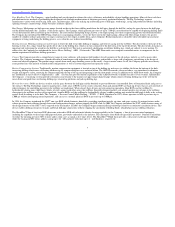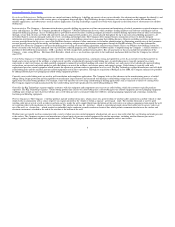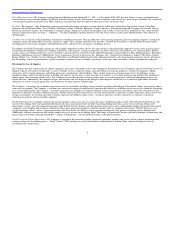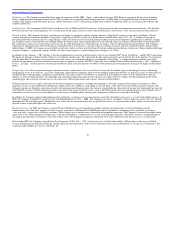National Oilwell Varco 2012 Annual Report Download - page 18
Download and view the complete annual report
Please find page 18 of the 2012 National Oilwell Varco annual report below. You can navigate through the pages in the report by either clicking on the pages listed below, or by using the keyword search tool below to find specific information within the annual report.
Index to Financial Statements
Research and New Product Development and Intellectual Property
The Company believes that it has been a leader in the development of new technology and equipment to enhance the safety and productivity of drilling and well servicing
processes and that its sales and earnings have been dependent, in part, upon the successful introduction of new or improved products. Through its internal development
programs and certain acquisitions, the Company has assembled an extensive array of technologies protected by a substantial number of trade and service marks, patents, trade
secrets, and other proprietary rights.
As of December 31, 2011, the Company held a substantial number of United States patents and had several patent applications pending. Expiration dates of such patents range
from 2012 to 2030. As of this date, the Company also had foreign patents and patent applications pending relating to inventions covered by the United States patents.
Additionally, the Company maintains a substantial number of trade and service marks and maintains a number of trade secrets.
Although the Company believes that this intellectual property has value, competitive products with different designs have been successfully developed and marketed by
others. The Company considers the quality and timely delivery of its products, the service it provides to its customers and the technical knowledge and skills of its personnel
to be as important as its intellectual property in its ability to compete. While the Company stresses the importance of its research and development programs, the technical
challenges and market uncertainties associated with the development and successful introduction of new products are such that there can be no assurance that the Company
will realize future revenues from new products.
Engineering and Manufacturing
The manufacturing processes for the Companys products generally consist of machining, welding and fabrication, heat treating, assembly of manufactured and purchased
components and testing. Most equipment is manufactured primarily from alloy steel, and the availability and price of alloy steel castings, forgings, purchased components and
bar stock is critical to the production and timing of shipments. Primary manufacturing facilities for the Rig Technology segment are located in Houston, Galena Park, Sugar
Land, Conroe, Cedar Park, Anderson, San Angelo, Fort Worth and Pampa, Texas; Duncan, Oklahoma; Orange, California; Edmonton, Canada; Aberdeen, Scotland;
Kristiansand, Stavanger and Arendal, Norway; Etten-Leur and Groot-Ammers, the Netherlands; Carquefou, France; Singapore; Lanzhou and Shanghai, China; Dubai, UAE;
and Ulsan, South Korea.
The Petroleum Services & Supplies segment manufactures or assembles the equipment and products which it rents and sells to customers, and which it uses in providing
services. Downhole tools are manufactured at facilities in Houston, Texas; Manchester, England; Dubai, UAE; Macaé, Brazil and Singapore. Drill Bits are manufactured at
facilities in Conroe, Texas; Stonehouse, U.K; and Jurong, Singapore. Drill Stem technology development and drill pipe are manufactured at facilities in Navasota, Texas;
Veracruz, Mexico; Jurong, Singapore; and Baimi Town, Jiangyan and Jiangsu, China. Solids control equipment and screens are manufactured at facilities in Houston and
Conroe, Texas; New Iberia, Louisiana; Aberdeen, Scotland; Trinidad; Shah Alum and Puncak Alam, Malaysia; and Macae, Brazil. Pumps are manufactured at facilities in
Houston, Odessa and Marble Falls, Texas; McAlester and Tulsa, Oklahoma; Manchester and Newcastle, England; Melbourne, Australia; and Buenos Aires, Argentina. NOV
IntelliServ manufactures and assembles equipment in Provo, Utah. The Company manufactures tubular inspection equipment and tools at its Houston, Texas facility for resale,
and renovates and repairs equipment at its manufacturing facilities in Houston, Texas; Celle, Germany; Singapore; and Aberdeen, Scotland. Fiberglass and composite tubulars
and fittings are manufactured at facilities in San Antonio, Burkburnett and Mineral Wells, Texas; Little Rock, Arkansas; Tulsa, Oklahoma; Wichita, Kansas; Geldermalsen,
the Netherlands; Betim, Brazil; Johor, Malaysia; Singapore and Harbin and Suzhou, China, while tubular coatings are manufactured in its Houston, Texas facility, or through
restricted sale agreements with third party manufacturers. Certain of the Companys manufacturing facilities and certain of the Companys products have various
certifications, including, ISO 9001, API, APEX and ASME.
Raw Materials
The Company believes that materials and components used in its servicing and manufacturing operations and purchased for sales are generally available from multiple
sources. The prices paid by the Company for its raw materials may be affected by, among other things, energy, steel and other commodity prices; tariffs and duties on
imported materials; and foreign currency exchange rates. In 2006 and 2007, the price for mild steel and standard grades stabilized while specialty alloy prices continued to rise
driven primarily by escalation in the price of the alloying agents. However, toward the end of 2007, the Company began to see price escalations in all grades of steel that
continued into 2008. During 2008, steel prices stabilized and the Company began to experience some declines in steel prices late in 2008 and throughout 2009. The Company
has generally been successful in its effort to mitigate the financial impact of higher raw materials costs on its operations by applying surcharges to and adjusting prices on the
products it sells. Furthermore, the Company continued to expand its supply base starting in 2006 throughout the world to address its customers needs. In 2011, the Company
witnessed moderate increases in steel pricing somewhat mitigated by improved sourcing and supply chain practices. The Company anticipates flat to slight increases in steel
pricing in 2012. Higher prices and lower availability of steel and other raw materials the Company uses in its business may adversely impact future periods.
17
























